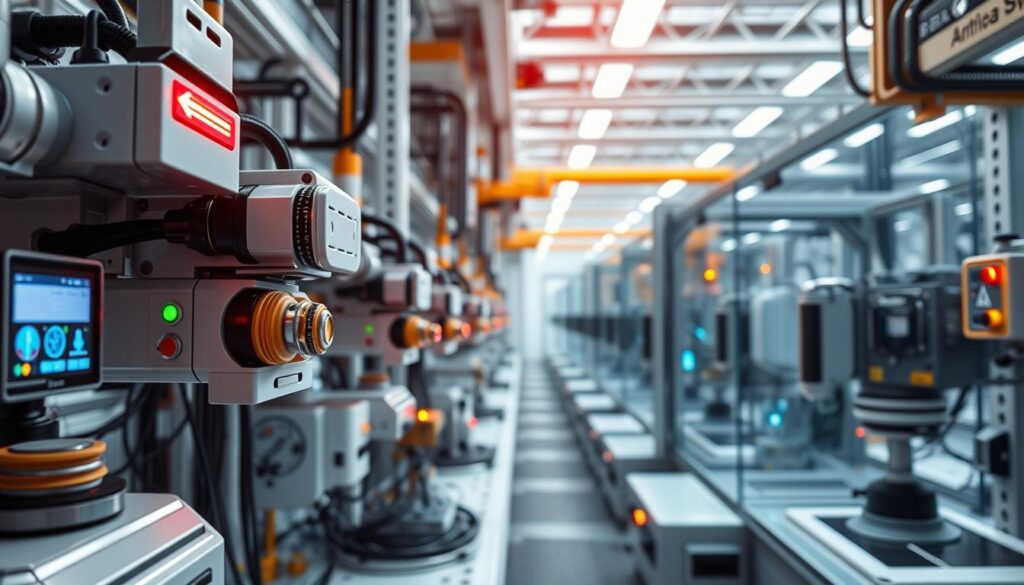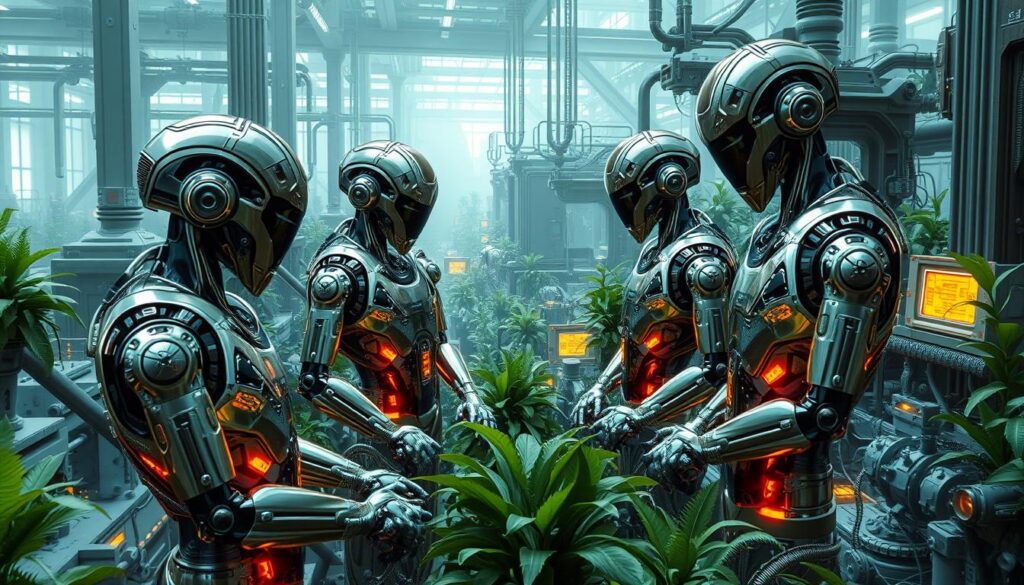What Happens When Robots Can Build Other Robots?

Imagine a world where robots can build other robots. This idea is now becoming a reality. Thanks to advanced robotics technology, self-replicating robots are becoming more possible. Their impact could be huge.
Exploring self-replicating robots, we must look at robotics technology’s progress. These robots could change many industries, from making things to helping in healthcare.

The possibilities for self-replicating robots are endless. They could change how we live and work. As we move forward, understanding their benefits and challenges is key to our future.
Key Takeaways
- Self-replicating robots are becoming a reality, thanks to advancements in robotics technology
- The potential impact of self-replicating robots on various industries is significant
- Robotics technology is rapidly evolving, enabling new possibilities for innovation and growth
- Self-replicating robots could transform the way we live and work
- Understanding the benefits and challenges of self-replicating robots is crucial for shaping our future
- The integration of self-replicating robots into our society will require careful consideration of their potential implications
The Current State of Self-Replicating Robotics
Self-replicating robotics has seen big steps forward lately. This is thanks to artificial intelligence and the manufacturing revolution. Robots now can build other robots, making production faster and cheaper. This tech could change many fields, like making things and healthcare.
Important advances include 3D printing and robotic assembly. These allow robots to make complex things and put parts together with great accuracy. Artificial intelligence also helps robots make better choices and learn from their experiences.
Top places like MIT and Stanford are leading in this field. They’re working on robots that can build and take apart themselves. Their aim is to make robots that can handle different tasks and environments.
The benefits of self-replicating robots are huge. They could make making things cheaper and more efficient. They also might help create complex structures that are hard to make now.
| Research Institution | Project | Description |
|---|---|---|
| MIT | Robotic Assembly | Developing robotic systems that can assemble and disassemble themselves |
| Stanford | Self-Replicating Robotics | Creating robots that can adapt to different environments and perform a variety of tasks |
The manufacturing revolution is pushing self-replicating robotics forward. Artificial intelligence is a big part of this. As research goes on, we’ll see even better production and lower costs.
Understanding the Technology Behind Robot Self-Replication
The robotics industry has seen big changes lately. Innovation in robotics is leading this growth. Robot self-replication lets robots make and put together other robots. This could change how we make things, making it cheaper and more efficient.
To get how robot self-replication works, we need to look at the basics of robotics and artificial intelligence. The robotics industry has made great strides in creating robots that can do complex tasks. Innovation in robotics has also brought us better sensors and control systems. These help robots move and work with their surroundings.
- Modular design: Robots are made to be easy to put together and take apart.
- Advanced sensors: Robots have special sensors to sense and react to their world.
- Artificial intelligence: Robots use AI to move around, interact, and learn from their experiences.
The robotics industry is always coming up with new tech and ideas. Innovation in robotics will keep being important for the future of making things. As robots get better at making and putting together other robots, we’ll see big improvements in how things get made.
What Will Happen When a Robot Can Build Another Robot?
As robots get closer to building other robots, we must think about what this means. The manufacturing world will change a lot. This could lead to new jobs and ways of working.
Robots making more robots might mean fewer jobs for people. But, it could also mean a better work life for many. It’s all about how we adapt.
Keeping robots safe will be a big deal. We’ll need to make sure they work well without causing harm. Experts say this could bring big benefits, but we must watch out for risks.
Manufacturing Revolution
Robots making more robots will change how we make things. This could make production faster and cheaper. It might also make products better and more consistent.
- Increased efficiency and productivity
- Reduced labor costs
- Improved product quality and consistency
Economic Implications
Robots making more robots will affect jobs and businesses. We need to think about how this will change our economy. It’s important to find ways to help those who might lose their jobs.
Workforce Transformation
When robots start making more robots, we’ll need to teach people new skills. This will help workers keep up with the changes. It will also open up new career paths in robotics.
The Role of Artificial Intelligence in Robot Manufacturing
Artificial intelligence is crucial in robot manufacturing. It lets robots learn, adapt, and make choices on their own. As robotics evolves, AI will lead the way, pushing the field forward. Robots will get better at their jobs thanks to AI’s help in learning, decision-making, and quality control.
Some key aspects of AI in robot manufacturing include:
- Machine learning integration, allowing robots to learn from experience and improve their performance
- Decision-making capabilities, enabling robots to make autonomous decisions and adapt to new situations
- Quality control systems, ensuring that robots produce high-quality products and detect any defects or irregularities
As AI gets better, robot manufacturing will see big improvements. This means more productivity, efficiency, and new ideas. The future of robotics looks bright, with AI leading the charge. Robots will become more vital in our world.
AI is the key to unlocking the full potential of robots, and as we continue to develop and refine AI technologies, we can expect to see significant advancements in the field of robotics.
Economic Impact of Self-Replicating Robots
The rise of self-replicating robots will change the economy a lot. This change comes from innovation in robotics. As the robotics industry expands, we’ll see more efficiency and productivity. This will lead to economic growth.
Some big economic benefits of self-replicating robots are:
- Lower production costs
- More productivity
- Better product quality
But, there are also downsides to think about. These include job loss and economic shake-ups. Studies and forecasts show the robotics industry will grow a lot. This growth is thanks to innovation in robotics.
The economic effect of self-replicating robots depends on how we use innovation in robotics. We need to understand the good and bad sides. This way, we can make sure the robotics industry helps the economy grow and brings prosperity.
Safety and Control Mechanisms
The manufacturing revolution is moving fast, and safety in self-replicating robots is key. It’s important to have safety protocols to avoid accidents and keep these robots safe. This means having failsafe systems, needing human oversight, and having emergency shutdowns.
Self-replicating robots are a big step forward, but safety must come first. Robust safety guidelines and regulations are needed to control these robots. This way, we can use their benefits while keeping risks low.
Failsafe Systems
Failsafe systems stop the robot if it malfunctions or makes an error. They are crucial for keeping self-replicating robots safe and preventing dangers.
Human Oversight Requirements
Having humans watch over these robots is vital. It helps prevent accidents and makes sure they are used right.

Emergency Shutdown Protocols
Emergency shutdowns can stop the robot quickly in an emergency. These are key to avoiding accidents and keeping self-replicating robots safe.
By focusing on safety, like failsafe systems, human oversight, and emergency shutdowns, we can make self-replicating robots safe. This will help the manufacturing revolution help everyone.
Ethical Considerations and Societal Impact
The rise of self-replicating robots brings up big questions about ethics and society. As we move forward with robotics, we must think about how it will affect us. One big worry is jobs, since robots can do tasks that humans used to.
There’s also the worry about resources, as more robots might mean more need for them. This could put a strain on the environment. The robotics technology itself could also harm the planet, by using more energy and creating more waste. We need to make sure we use robots in a way that’s good for the planet.
Here are some key things to think about when making self-replicating robots:
- Make sure the process is open and fair
- Put in place strong safety measures to avoid accidents and misuse
- Find ways to use resources wisely and manage waste well
By tackling these issues, we can make sure robotics technology helps people and the planet. This way, we can create a bright and green future of robotics.
| Category | Considerations | Strategies |
|---|---|---|
| Job Displacement | Potential loss of jobs, impact on workforce | Retraining programs, education initiatives |
| Resource Allocation | Increased demand for resources, potential environmental strain | Sustainable practices, responsible resource management |
| Environmental Implications | Potential increase in energy consumption, waste generation | Energy-efficient designs, waste reduction strategies |
Legal Framework and Regulatory Challenges
As self-replicating robots become a reality, we must address the legal and regulatory challenges. The use of artificial intelligence in these robots raises safety, ethics, and liability concerns. A balanced approach is needed to promote innovation while keeping safety and ethics in check.
The development of self-replicating robots will need updates to current laws and regulations. Key considerations include:
- Intellectual property rights for robot-created products
- Liability for accidents or damages caused by self-replicating robots
- Regulations for the use of artificial intelligence in robot manufacturing
A
report by the National Institute of Standards and Technology
shows the need for a comprehensive regulatory framework. This framework must address the unique challenges of artificial intelligence. It should ensure these robots are safe and ethically made.

In conclusion, we must carefully consider the legal and regulatory challenges of self-replicating robots. By addressing these challenges and promoting a balanced approach, we can responsibly develop and deploy this technology. This will help drive innovation and economic growth.
Conclusion: Shaping a Future with Self-Replicating Robots
The potential of self-replicating robots is both thrilling and complex. They could make our work more efficient and innovative. But, they also bring up big questions about ethics, economy, and society.
Researchers, policymakers, and industry leaders must work together. They need to make sure these robots help humanity and the planet. This means keeping them safe and thinking about how they can make our future better.
By carefully planning the future of self-replicating robots, we can use their benefits while avoiding their downsides. As this technology grows, it’s up to all of us to make sure it’s used for the good of everyone.
FAQ
What is the current state of self-replicating robotics?
Self-replicating robotics has made big strides lately. Early robot self-replication efforts have led to today’s tech. Now, top research places are working on robots making more robots. Artificial intelligence is key in this progress.
How does the technology behind robot self-replication work?
Robot self-replication uses robotics and AI. It combines machine learning and advanced manufacturing. This lets robots make copies of themselves. Safety and quality checks are vital for these robots to work right.
What are the potential economic implications of self-replicating robots?
Self-replicating robots could change the economy a lot. They might make manufacturing more efficient. But, they could also take jobs. Leaders need to think about how to make sure everyone benefits without losing jobs.
What safety and control mechanisms are in place for self-replicating robots?
Keeping self-replicating robots safe is crucial. They have failsafe systems and need human checks. These steps help avoid accidents and keep people trusting the tech.
What are the ethical considerations and societal impact of self-replicating robots?
Self-replicating robots bring up big ethical questions. They could lead to job loss and affect how we use resources. We need to talk about these issues to make sure the tech helps everyone, not just a few.
How will the legal framework and regulatory challenges evolve to accommodate self-replicating robots?
Laws and rules will change with self-replicating robots. We’ll need new laws for safety and who’s responsible. It’s important for everyone to work together to make sure the tech is safe and fair.





